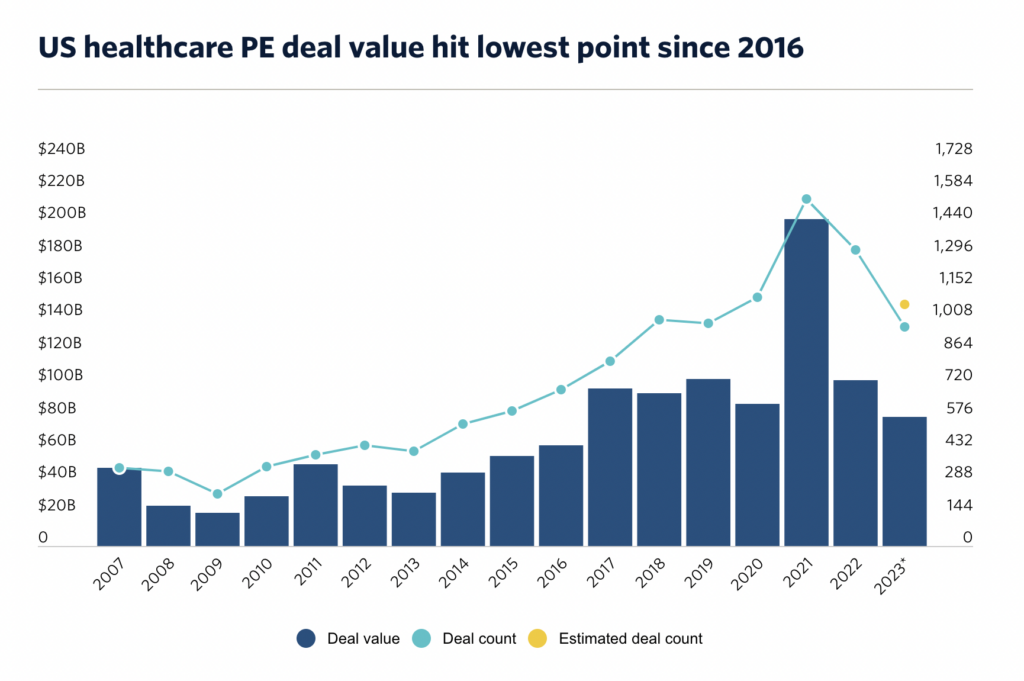

This article is a part of your HHCN+ Membership
Health care’s share of global private-equity (PE) deal count peaked at 13.7% in 2020. Three years later, that number fell to 10.8% — its lowest level since 2015.
Compared to the bustling activity of 2021, home-based care dealmaking was mostly sluggish in 2023 and has followed that same trend.
The slow year was largely due to PE firms’ reluctance to re-engage in the market. In 2024, those tides may shift ever so slightly, making it an intriguing year.
“So much of what we’re expecting to see from an activity standpoint is going to depend on whether or not the [Federal Reserve] adjusts interest rates,” Rebecca Springer, lead health care analyst at PitchBook, told Home Health Care News. “Higher interest rates could affect the value of future cash flows and exit valuations.”
Despite 2023 being a down year for home-based care dealmaking, it was a relatively strong year for PE health care specialists in terms of cumulative dollars closed, according to Pitchbook. However, that fundraising activity is not expected to translate into increased deal counts in 2024.


“Dry powder or available capital is not always indicative of future dealmaking,” Springer said. “The typical investment period for a 10-year fund is five years with some additional flexibility through a number of technicalities. In 2024, we anticipate that PE health care managers will focus on deploying capital into existing portfolio companies, lower-middle-market platforms and occasionally pursue opportunistic carve outs.”
Slow start expected
Home-based care is in a particularly interesting position when it comes to M&A and PE-involved deals, Cory Mertz, managing partner at Mertz Taggart, told HHCN.
There’s a contrast in financial strategies that exists between physician groups and home-based care companies.
Physician groups, Mertz explained, rely heavily on growth through acquisition and accumulating significant debt in the process.
“Once you buy a physician practice, it’s hard to grow that significantly organically,” Mertz said. “You just have to keep buying them so it’s almost entirely a roll-up strategy. They’re dealing with organic growth, so you’re piling on more debt deal after deal.”
In contrast, mature home-based care companies — especially those owned by established private equity groups — often have cash reserves due to early investments and successful organic growth.
This financial stability enables them to expand without relying heavily on debt financing, giving them a competitive edge in dealmaking.
“On the home-based care side, there are some buyers out there that are cash-strapped,” Mertz said. “Especially those that overpaid for platforms between 2020 and 2021. A lot of those guys are probably a little bit cash-strapped or a little bit more highly leveraged because they overpaid. They put debt on it and they haven’t had a chance to really grow organically and throw a bunch of cash on the balance sheet.”
Both Mertz and Springer mentioned that it’s not a matter of quantity, but quality.
“Not all of them, but the more recent portfolio platform deals that we’ve seen over the last year or two — they’re going to have a harder time being aggressive if they’re looking for quality companies,” Mertz said.
Macroeconomic factors will continue to play a huge role in PE’s involvement for home-based care in 2024, Springer said.


“The drop in provider add-on activity we saw last year happened for two reasons,” Springer said. “First, the industry has been hit hard by labor cost inflation. It’s improving slightly as macroeconomic conditions change, but it’s clear that the pandemic has only worsened the ongoing labor shortages across various sectors, from urology and dental hygiene to home health care. Second — and most importantly — high interest rates and roll-ups do not mix well.”
It’s becoming more risky for PE firms to rely on borrowing money to fuel rapid growth through acquisitions. As a result, the industry is shifting focus in different directions like, as Pitchbook has pointed out, behavioral health and aesthetics.
Others are moving away from traditional health care providers and investing more in tech and pharmaceutical services.
Year of two halves
Private equity investors told HHCN on background that despite some of the caution being taken by investors, the second half of the year could be a busier one.
Investors and analysts called it a “mixed bag” when projecting what 2024 will look like.
In speaking with other investors, Mertz has received a similar message.
“The ones that have been under the same ownership group or even some of the publicly traded companies have got plenty of cash and they are looking for quality opportunities,” Mertz said. “But then there are some that are saying, ‘Right now, we have to focus on organic growth and integrating these deals that we’ve done in the last 12 months.’ At least for the first half of the year. That’s the general sentiment I’m getting.”
As will be the case for 2024 and following years, one of the biggest obstacles PE investors face is a lack of high-quality deals available. The other — as Springer pointed out — is the capital markets.
“The first thing they all say is quality deal flow,” Mertz said. “They’ll say, ‘There’s just not enough quality opportunities out there for us to sink our teeth into.’ And, with the capital markets, the consensus is that the Fed will start cutting rates in the second quarter of 2024. Buyers, especially those that rely on debt, are waiting for things to ease up a bit before they get acquisitive.”

